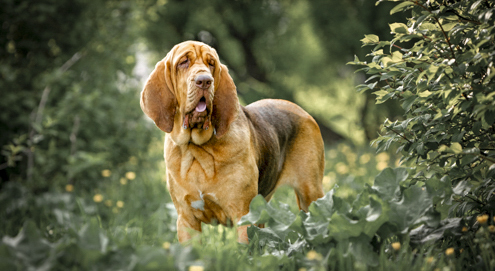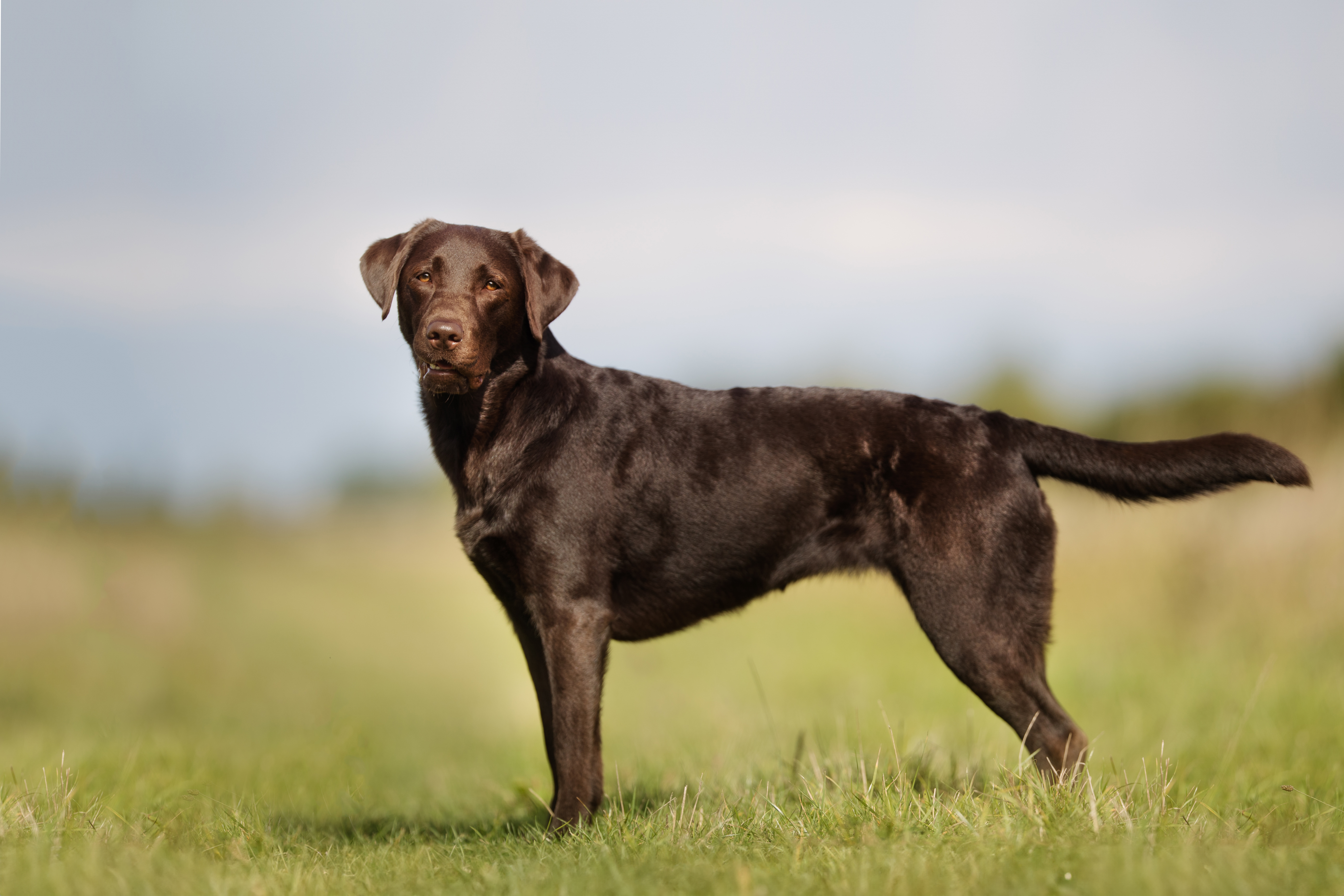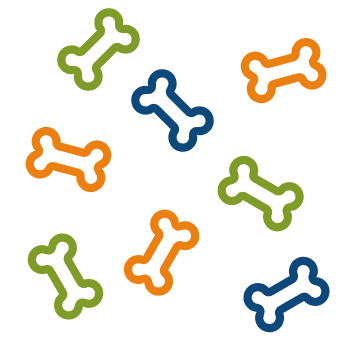
What is the best dog food?
The answer to the above question is subjective and depends on your own preference and that of your dog. We’ve made an overview of the most popular diets in every category, using our extensive range of dog foods.
The Bloodhound, also known as the Saint Hubert Hound, is a large, gentle dog with an exceptional sense of smell and a friendly temperament. Originally bred for tracking wounded game, it is now valued as a companion dog and used in search and rescue operations. Its patient and affectionate nature makes it suitable for families with children and other pets. The Bloodhound is intelligent and eager to learn but can sometimes be stubborn, which requires consistent and loving training. With its unique appearance and endearing personality, the Bloodhound is a special addition for lovers of large dogs with a gentle character.

The Bloodhound, also known as the Saint Hubert Hound, has a rich history dating back to the Middle Ages. This breed originated in Belgium, where it was bred by monks at the Abbey of Saint Hubert. The monks aimed to develop a dog with an exceptional sense of smell and a calm, gentle nature, suitable for tracking wounded game during hunts. Over time, the Bloodhound became known for its tracking abilities and reliability, making it not only popular among hunters but also a favorite among noble families across Europe. The breed was named for its “pure bloodline” and not due to any association with blood. With the rise of modern tracking and detection techniques, the Bloodhound found a new role as a search and rescue dog. Its exceptional sense of smell and patience make it ideal for following trails over long distances, even days after the scent was lost.
The Bloodhound is known for its gentle and patient temperament, making it an ideal companion dog. This breed is extremely loyal and forms strong bonds with its family, allowing it to get along well with both adults and children. Its friendly nature also usually makes it tolerant of other pets. Although the Bloodhound is intelligent, it can be quite stubborn, which can make training a challenge. It’s important to consider its strong instincts as a scent hound; once it picks up a scent, it can become completely focused and difficult to recall. Due to its sensitive nature, the Bloodhound feels most at ease in a calm, stable environment where it receives enough attention and mental stimulation. It is alert but not aggressive, and will only bark when truly necessary. This breed is an excellent choice for families looking for a loving, loyal dog with a unique personality.
The Bloodhound has a striking appearance that is immediately recognizable. Its large, powerful body features a deep chest, straight back, and strong, muscular legs. The head is long and narrow, with a prominent occipital bone and a distinct stop leading to the muzzle. What truly makes the Bloodhound unique are the loose folds of skin around its head and neck, giving it a characteristic and distinguished look. Its long, low-set ears hang gracefully along its cheeks, and its deep-set eyes give it a gentle, slightly mournful expression. The short, dense coat of the Bloodhound feels firm and comes in several colors, including black and tan, reddish-brown, or liver-colored. With its sturdy build and distinctive features, the Bloodhound exudes strength and charm.
The Bloodhound is an active dog that needs plenty of daily exercise to stay healthy and happy. Long walks are essential for this breed, preferably in quiet surroundings where it can use its scent-tracking instincts. Scent games and other activities that involve using its nose are ideal to challenge it both physically and mentally. Although typically calm indoors, the Bloodhound needs ample outdoor space to move and explore. Due to its powerful sense of smell, it can become completely absorbed in a scent trail, so it must always be on a leash or in a securely fenced area. Regular exercise not only helps prevent obesity and health issues but also keeps boredom at bay. An active lifestyle, combined with sufficient attention, makes the Bloodhound a content and well-balanced dog.
The Bloodhound’s coat is relatively easy to maintain, but its loose skin folds and long ears require special attention. Weekly brushing of the short, dense coat helps remove dead hairs and keeps the skin healthy. During shedding periods, more frequent brushing may be necessary. The loose folds of skin, especially around the head and neck, should be checked and cleaned regularly to prevent irritation or infection. Make sure these folds remain dry after cleaning. The long, drooping ears also need extra care—check and clean them weekly to keep them healthy. Brushing the dog’s teeth is recommended to prevent plaque buildup and gum issues, and nails should be trimmed when needed to prevent discomfort while walking.
A balanced diet and sufficient exercise are essential to maintaining a healthy weight, as excess weight can strain the joints. Regular veterinary check-ups are important to monitor overall health and catch any issues early. With the right routine and care, the Bloodhound stays in good condition and can fully enjoy its active and social life.
The Bloodhound is prone to several health issues, many of which are related to its size and build. Hip dysplasia is common in this breed and can cause pain and mobility issues, especially in older dogs. Another serious risk is gastric torsion, or bloat—a life-threatening condition where the stomach twists, often triggered by rapid eating or drinking combined with exercise.
The Bloodhound’s long, drooping ears make it susceptible to ear infections. Regular inspection and cleaning are essential. The loose skin folds on its head and neck can also cause problems, as they are prone to irritation and infection if they remain moist. Additionally, eye issues such as entropion or ectropion (where the eyelids turn inward or outward) can cause discomfort and infections.
Because of its size, the Bloodhound also has an increased risk of joint problems like arthritis, especially later in life. Choosing a responsible breeder and ensuring regular veterinary care can help detect and manage these conditions early, allowing the Bloodhound to lead a healthy and happy life.
While the Bloodhound has unique characteristics, there are other breeds that are similar in appearance, temperament, or skills. These breeds often share a strong sense of smell and a friendly, gentle nature, although each has its own traits. Similar breeds include:
When buying a Bloodhound, it’s essential to proceed with care, given the breed’s specific needs and health risks. Finding a responsible and experienced breeder is a crucial first step. A reputable breeder performs health tests on the parent dogs, such as screenings for hip dysplasia and eye problems, and provides insight into the pups’ hereditary health.
It is important to check whether the puppies are well-socialized. This means they are already accustomed to human interaction and various situations, which contributes to a stable and well-balanced temperament. Ask about the temperament of the parent dogs, as this often indicates the pup’s potential temperament. During your visit to the litter, observe the living conditions of the puppies. They should be raised in a clean, safe, and stimulating environment. Choose a breeder who is open and transparent about the puppies’ upbringing and willing to answer questions about Bloodhound care and training.
You should also consider the costs associated with owning a large breed. This includes food, veterinary care, training, and potential health issues. Additionally, it’s important to be aware of the time and attention this breed requires, especially due to its strong scenting instinct and sensitive nature.
The Bloodhound is a gentle and intelligent dog with a strong tracking instinct, making it well-suited for owners with specific qualities. This breed has unique needs and a distinctive personality that make it ideal for a patient and dedicated owner. Considering getting a Bloodhound? Then it’s important to understand what traits are needed to properly care for this dog. Below are several key points to help determine if this breed is right for you:
The Bloodhound is suitable for an owner who:
Due to its strong tracking instinct, independence, and specific care needs, the Bloodhound is not always the best choice for first-time dog owners. It requires a calm, consistent approach and regular grooming, which can be a challenge for those without experience handling large or headstrong breeds.
Experienced owners who are familiar with training independent dogs will be better equipped to understand and guide its unique traits. This breed can be a fantastic choice for someone who appreciates its gentle nature and is willing to invest time and energy in its care and training.
The Bloodhound is an excellent match for a patient and experienced owner who values its love of tracking and loyal character. With the right care and attention, it becomes a wonderful and devoted companion.

The answer to the above question is subjective and depends on your own preference and that of your dog. We’ve made an overview of the most popular diets in every category, using our extensive range of dog foods.

If you've ever owned a dog, you'll know that every dog is unique. Dogs can have breed-specific characteristics, though, like joint or coat issues. To support these specific characteristics, Royal Canin has created special nutrition that meets the needs of individual dog breeds. Read all about breed-specific dog food in this article!

Getting a new pet always involves one important question: what will we name him or her? The names we choose for our dogs often reflect the things that matter most to us, from our passions and interests to what's happening in the world around us. Or maybe you are just looking for a funny or silly name. Anything is possible! Have you recently adopted or are planning to adopt a dog? Are you looking for inspiration? We've put together a few lists that might help you choose a suitable name.

Add products to view your basket
We use cookies to help us serve you better and more personally. Functional cookies ensure that the website works properly and have an analytical function. We also use technology to track your behaviour anonymously, both inside and outside our website. Personal data and cookies may be used for personalisation or advertising. Want to know more? Read our privacy policy and cookie statement here. If you choose to reject, we will only place functional and analytical cookies.
